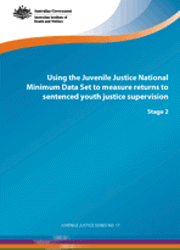Summary
In Australia, youth justice departments are responsible for providing services to young people sentenced to community-based supervision or detention. These services aim to reduce the frequency and seriousness of youth offending. When considered with other outcome indicators, the rate of return to sentenced supervision is one possible indicator of the performance of a youth justice department (although there are factors beyond the control of youth justice departments that will impact on the level of reoffending). This is the second report that examines measures of returns to sentenced youth justice supervision using data from the Juvenile Justice National Minimum Data Set (JJ NMDS). The first report (AIHW 2013) explored the feasibility of using this longitudinal person-based data set, which contains information on young people under supervision, and found that it was possible to fulfil many of the principles developed by Richards (2011). This second report further examines timeframes for measuring returns and explores the potential for using JJ NMDS data to measure the seriousness of reoffending.
Timeframes for measuring returns to sentenced supervision
Returns to sentenced supervision can be measured over a number of timeframes. While longer timeframes will capture more returns, the nature of youth justice supervision means that the cohort used for analysis must be age restricted. Shorter timeframes allow for more recent data to be used, but will be affected by the length of time required for administrative procedures such as court proceedings. Based on a comparison of 5 timeframes (returns within 3 months, 6 months, 1 year, 2 years and at any time during possible youth justice supervision), it is recommended that timeframes of 6 months and 1 year be used. It is also recommended that analyses be contextualised by the impact of prior supervised sentences to account for the effect of offending history on the type of sentence received.
Measuring the seriousness of reoffending
Measuring whether the seriousness of offending has escalated could also provide valuable information on performance. The JJ NMDS contains offence data for 3 states and preliminary analyses of the escalation of reoffending are provided in this report. However, it is unlikely that offence data for the remaining states and territories will be available in the foreseeable future. One possible alternative that uses available JJ NMDS data is the severity of supervised sentences received for reoffending. A preliminary analysis found that an increase in sentence severity was more likely to correspond with an increase in offence seriousness than with a decrease or no change in offence seriousness. This indicates that an increase in sentence severity can be used as a proxy indicator of an escalation of offending behaviour in the absence of offence data, although sentence severity is also influenced by other factors. It is recommended that this measure be used until offence data for all states and territories are available.
Future work
Recommendations for future work include agreeing on measures to be reported annually and exploring the feasibility of using other data sources in addition to the JJ NMDS to enable a more comprehensive analysis on youth recidivism.



